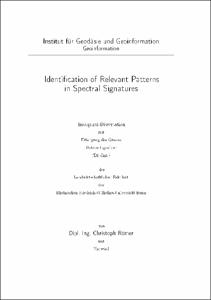Römer, Christoph: Identification of Relevant Patterns in Spectral Signatures. - Bonn, 2016. - Dissertation, Rheinische Friedrich-Wilhelms-Universität Bonn.
Online-Ausgabe in bonndoc: https://nbn-resolving.org/urn:nbn:de:hbz:5n-42188
Online-Ausgabe in bonndoc: https://nbn-resolving.org/urn:nbn:de:hbz:5n-42188
@phdthesis{handle:20.500.11811/6592,
urn: https://nbn-resolving.org/urn:nbn:de:hbz:5n-42188,
author = {{Christoph Römer}},
title = {Identification of Relevant Patterns in Spectral Signatures},
school = {Rheinische Friedrich-Wilhelms-Universität Bonn},
year = 2016,
month = jan,
note = {For Plant Phenotyping, non-invasive measurements of early stress processes in plants and the quantification of soil parameters with hyperspectral sensors are of particular importance, but relevant information is often concealed in the data. While the relevant parameters are measured, only a combination of different, very application-specific methods may reveal them. Even though promising results have been achieved by using supervised machine learning methods, existing features are not optimal. In other cases, labels are not obtainable or, especially for soil measurements, the information about the searched parameters is masked in the spectrum itself. In this thesis, new methods are developed to quantify and visualize relevant processes for Plant Phenotyping from hyperspectral data. New features are constructed in order to deal with the bad signal to noise ratio of early stress processes. These features are describing the information about the whole spectrum by piece-wise polynomials. The new features enable an earlier and more accurate prediction of stress symptoms despite noisy measurements. A method is presented to extract labels from unlabeled hyperspectral images. For this, an unsupervised archetypal matrix factorization is used to construct a second order feature space. The new feature space enables the prediction of early drought stress on the plant level. A hierarchical classification approach is developed to deal with relevant parameters masked by undesirable influences on the spectrum. The hierarchical approach eliminates the variance resulting from these disturbing influences. This enables more accurate regression and classification models. The presented methods succeed in an earlier stress prediction and a significant improvement in soil parameter quantification from hyperspectral data.},
url = {https://hdl.handle.net/20.500.11811/6592}
}
urn: https://nbn-resolving.org/urn:nbn:de:hbz:5n-42188,
author = {{Christoph Römer}},
title = {Identification of Relevant Patterns in Spectral Signatures},
school = {Rheinische Friedrich-Wilhelms-Universität Bonn},
year = 2016,
month = jan,
note = {For Plant Phenotyping, non-invasive measurements of early stress processes in plants and the quantification of soil parameters with hyperspectral sensors are of particular importance, but relevant information is often concealed in the data. While the relevant parameters are measured, only a combination of different, very application-specific methods may reveal them. Even though promising results have been achieved by using supervised machine learning methods, existing features are not optimal. In other cases, labels are not obtainable or, especially for soil measurements, the information about the searched parameters is masked in the spectrum itself. In this thesis, new methods are developed to quantify and visualize relevant processes for Plant Phenotyping from hyperspectral data. New features are constructed in order to deal with the bad signal to noise ratio of early stress processes. These features are describing the information about the whole spectrum by piece-wise polynomials. The new features enable an earlier and more accurate prediction of stress symptoms despite noisy measurements. A method is presented to extract labels from unlabeled hyperspectral images. For this, an unsupervised archetypal matrix factorization is used to construct a second order feature space. The new feature space enables the prediction of early drought stress on the plant level. A hierarchical classification approach is developed to deal with relevant parameters masked by undesirable influences on the spectrum. The hierarchical approach eliminates the variance resulting from these disturbing influences. This enables more accurate regression and classification models. The presented methods succeed in an earlier stress prediction and a significant improvement in soil parameter quantification from hyperspectral data.},
url = {https://hdl.handle.net/20.500.11811/6592}
}






